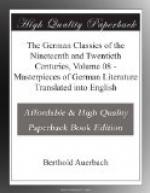In several musical authors of the first decade of the last century we find the remark that the fashionable taste in music had at that time suddenly veered around; a short time before, the greatest effects had been produced with the fastest possible tempo, the most animated rhythm and figures; now slow, solemn music was the order of the day. In the seventeenth century the twelve-eighths time was mainly employed for dance music and, in general, for quick movements; in the beginning of the eighteenth century, on the contrary, this species of time conveyed to people’s ears something quite different; it then became the conventional measure for the soft, yearning adagio. Haendel, in his lively gigs and in his lingering pastoral love arias, gives us side by side both conceptions of twelve-eighths time. In the second half of the century this species of time, so much in vogue formerly, disappears almost entirely. Generally speaking, in the period of Haydn the sense of rhythm undergoes a simplifying process, and many species of time are done away with altogether. There is, in this particular, no greater contrast than Haydn and Sebastian Bach. Haydn generalizes the rhythms in order to attain the most telling and universally comprehensible effect possible; Bach individualizes them in order to get the most subtle result possible. Haydn and his age were satisfied, in the main, with the four-fourths and two-fourths, three-fourths and six-eighths rhythm; he simplified all conceivable rhythmic forms in such a manner that it was possible to express them in one of these four rhythms. Bach employs at least three times as many species of time and is so hair-splitting in his selections that it is more often a question of a refinement of designation, of professional coquetting with the master secrets of technique, than of any real difference in the matter. Only it must be said that this, with him, springs from a feeling for the most delicate shades of rhythm, such as has never existed since. The ear of the whole Bach age had a much keener appreciation than ours, of the subtleties of rhythm. At that time, in order to distinguish in the ball-room whether a courante or a minuet, whether a gavotte or a bourree, were being played, a keenness of rhythmic instinct was necessary, of which in truth very little has survived in our young dancing people of today, who often have to bethink themselves whether it is a waltz or a polka which the music is beating in their ears with the rhythmic flail.




